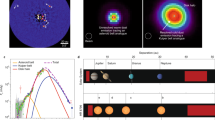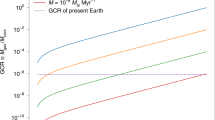Abstract
Circumstellar accretion disks transfer matter from molecular clouds to young stars and to the sites of planet formation. The disks observed around pre-main-sequence stars have properties consistent with those expected for the pre-solar nebula from which our own Solar System formed 4.5 Gyr ago1. But the ‘debris’ disks that encircle more than 15% of nearby main-sequence stars2,3,4,5 appear to have very small amounts of gas, based on observations of the tracer molecule carbon monoxide6,7,8: these observations have yielded gas/dust ratios much less than 0.1, whereas the interstellar value is about 100 (ref. 9). Here we report observations of the lowest rotational transitions of molecular hydrogen (H2) that reveal large quantities of gas in the debris disks around the stars β Pictoris, 49 Ceti and HD135344. The gas masses calculated from the data are several hundreds to a thousand times greater than those estimated from the CO observations, and yield gas/dust ratios of the same order as the interstellar value.
This is a preview of subscription content, access via your institution
Access options
Subscribe to this journal
Receive 51 print issues and online access
$199.00 per year
only $3.90 per issue
Buy this article
- Purchase on Springer Link
- Instant access to full article PDF
Prices may be subject to local taxes which are calculated during checkout

Similar content being viewed by others
References
Beckwith, S. W. V. & Sargent, A. I. Circumstellar disks and the search for neighbouring planetary systems. Nature 383, 139–144 ( 1996).
Aumann, H. et al. Discovery of a shell around Alpha Lyrae. Astrophys. J. 278, L23–L27 ( 1984).
Backman, D. E. & Paresce, F. in Protostars & Planets III (eds Levy, E. H. & Lunine, J. I.) 1253–1304 (Univ. Arizona Press, Tucson, 1993).
Habing, H. J. et al. Disappearance of stellar debris disks around main-sequence stars after 400 million years. Nature 401, 456–458 (1999).
Lagrange, A. M., Backman, D. E. & Artymowicz, P. in Protostars & Planets IV (eds Mannings, V., Boss, A. & Russell, S.) 639–672 (Univ. Arizona Press, Tucson, 2000).
Greaves, J. S., Coulson, I. M. & Holland, W. S. No molecular gas around nearby solar-type stars. Mon. Not. R. Astron. Soc. 312, L1– L3 (2000).
Zuckerman, B., Forveille, T. & Kastner, J. H. Inhibition of giant planet formation by rapid gas depletion around young stars. Nature 373, 494–496 (1995).
Dent, W. R. F., Greaves, J. S., Mannings, V., Coulson, I. M. & Walther, D. M. A search for molecular gas components in prototypical Vega-excess systems. Mon. Not. R. Astron. Soc. 277, L25–L29 ( 1995).
Hildebrand, R. H. The determination of cloud masses and dust characteristics from submillimeter thermal emission. Q. J. R. Astron. Soc. 24, 267–282 (1983).
de Graauw, T. et al. Observing with the ISO Short Wavelength Spectrometer. Astron. Astrophys. 315, L49–L54 (1996).
Kessler, M. et al. The Infrared Space Observatory (ISO) mission. Astron. Astrophys. 315, L64–L70 (1996).
Thi, W. F. et al. H2 and CO emission from disks around T Tauri, Herbig Ae and Vega-type stars: cold and warm circumstellar gas. Astrophys. J. (submitted).
Thi, W. F., van Dishoeck, E. F., Blake, G. A., van Zadelhoff, G. J. & Hogerheijde, M. R. Detection of H2 pure rotational line emission from the GG Tau circumbinary disk. Astrophys. J. 521, L63– L66 (1999).
Valentijn, E. A. & Thi, W. F. ISO's Short Wavelength Spectrometer—Ultimate sensitivity. Reducing the effects of cosmic weather. Exp. Astron. 10, 215–225 (2000).
Walker, H. J. & Heinrichsen, I. ISOPHOT observations of dust disks around main-sequence (Vega-like) stars. Icarus 143, 147–154 (2000).
Kamp, I. & Bertoldi, F. CO in the circumstellar disks of Vega and β Pictoris. Astron. Astrophys. 353, 276–286 (2000).
Sandford, S. A. & Allamandola, L. J. H 2 in interstellar and extragalactic ices—Infrared characteristics, ultraviolet production, and implications. Astrophys. J. 409, L65–L68 (1993).
Hollenbach, D. J., Yorke, H. W. & Johnstone, D. in Protostars & Planets IV (eds Mannings, V., Boss, A. & Russell, S.) 401–428 (Univ. Arizona Press, Tucson, 2000).
Lagrange, A. M. et al. The β Pic circumstellar disk. XXIV. Clues to the origin of the stable gas. Astron. Astrophys. 310, 1091–1108 (1998).
Heap, S. R. et al. STIS coronographic observations of β Pictoris. Astrophys. J. 539, 435–444 (2000).
Klahr, H. H. & Lin, D. N. C. Dust distribution in gas disks. A model for the ring around HR 4796A. Astron. J. (in the press).
Weidenschilling, S. J. Aerodynamics of solid bodies in the solar nebula. Mon. Not. R. Astron. Soc. 180, 57–70 (1977).
Artymowicz, P. & Clampin, M. Dust around main sequence stars: Nature or nurture by the interstellar medium? Astrophys. J. 490, 863–878 (1997).
Barrado y Navascués, D., Stauffer, J. R., Song, I. & Caillault, J. P. The age of β Pictoris. Astrophys. J. 520, L123–L126 ( 1999).
Siess, L., Forestini, M. & Bertout, C. Physics of accretion onto young stars. III. Comparisons with observations. Astron. Astrophys. 342, 480–491 (1999).
Dunkin, S. K., Barlow, M. J. & Ryan, S. G. High-resolution spectroscopy of Vega-like stars—II. Age indicators, activity and circumstellar gas. Mon. Not. R. Astron. Soc. 290, 165–185 ( 1997).
Zuckerman, B. & Webb, R. A. Identification of a nearby stellar association with the Hipparcos catalog: Implications for recent, local star formation. Astrophys. J. 535, 959– 964 (2000).
Jourdain de Muizon, M., Laureijs, R. J., Dominik, C. & Habing, H. J. A very cold disk of dust around the G2V star HD 207129. Astron. Astrophys. 350, 875–882 (1999).
Fajardo-Acosta, S. B., Stencel, R. E., Backman, D. E. & Thakur, N. Infrared Space Observatory photometric search of main-sequence stars for Vega-type Systems. Astrophys. J. 520, 215– 222 (1999).
Acknowledgements
This work was supported by The Netherlands Organization for Scientific Research (NWO). Additional support to G.A.B. from the NASA Infrared Space Observatory (ISO), Exobiology, and Origins of Solar Systems programmes is gratefully acknowledged. A.N. is supported in part by an Agenzia Spaziale Italiana (ASI) grant. This work is based on observations with ISO, a European Space Agency (ESA) project with instruments funded by ESA Member States (especially the Principal Investigator countries: France, Germany, the Netherlands, and the United Kingdom) and with the participation of the Institute of Space and Astronautical Sciences (ISAS) and the National Aeronautics and Space Administration (NASA).
Author information
Authors and Affiliations
Corresponding author
Rights and permissions
About this article
Cite this article
Thi, W., Blake, G., van Dishoeck, E. et al. Substantial reservoirs of molecular hydrogen in the debris disks around young stars. Nature 409, 60–63 (2001). https://doi.org/10.1038/35051033
Received:
Accepted:
Issue Date:
DOI: https://doi.org/10.1038/35051033
This article is cited by
-
The James Webb Space Telescope
Space Science Reviews (2006)
-
Debris Discs Around Stars: The 2004 ISO Legacy
Space Science Reviews (2005)
-
Enigmatic emission
Nature (2002)
-
Evidence for planet engulfment by the star HD82943
Nature (2001)
-
Time for gas planets to grow
Nature (2001)
Comments
By submitting a comment you agree to abide by our Terms and Community Guidelines. If you find something abusive or that does not comply with our terms or guidelines please flag it as inappropriate.



